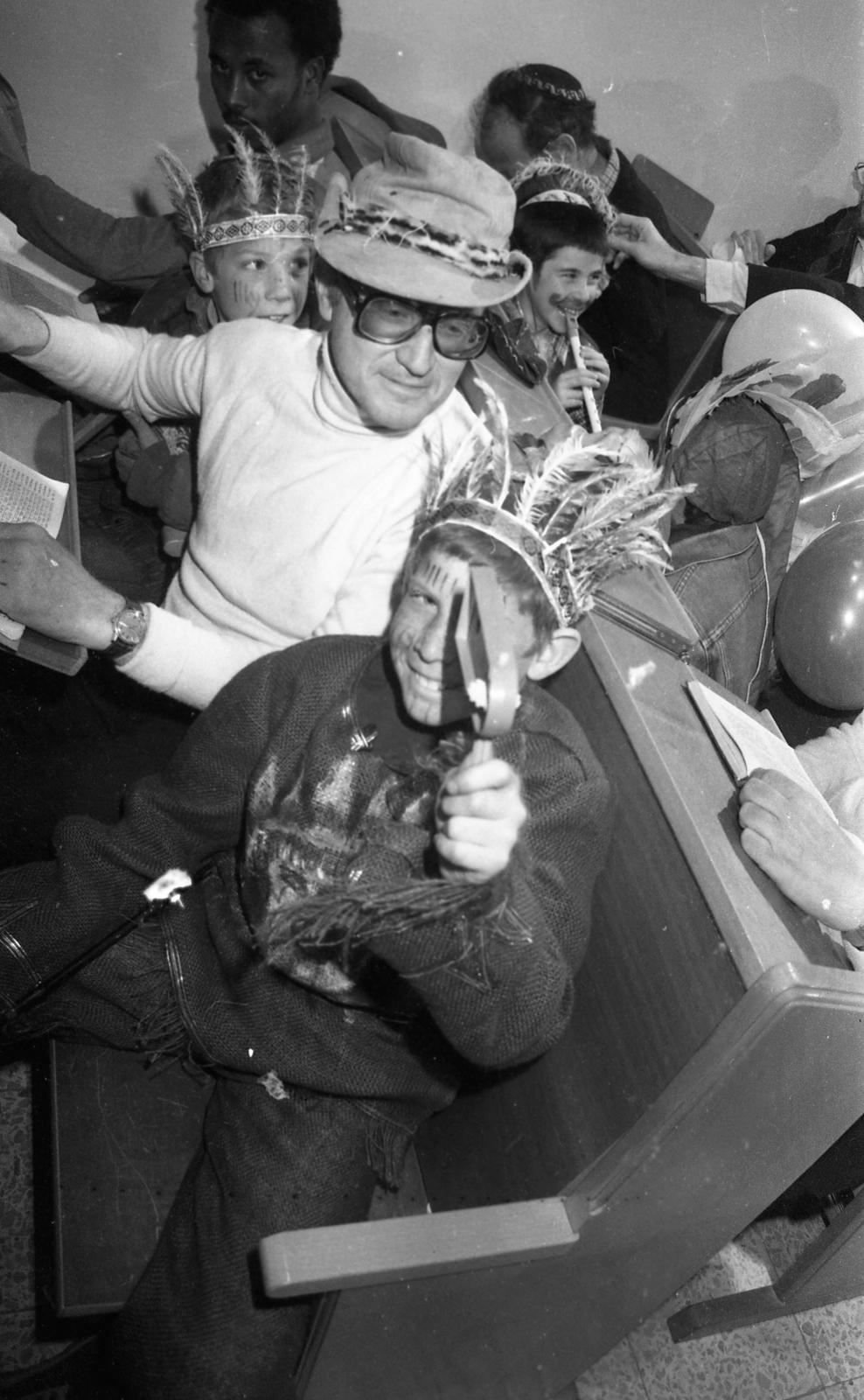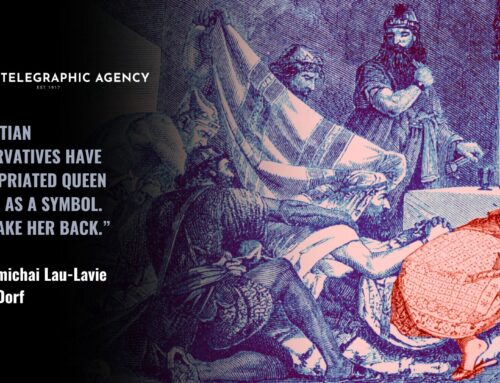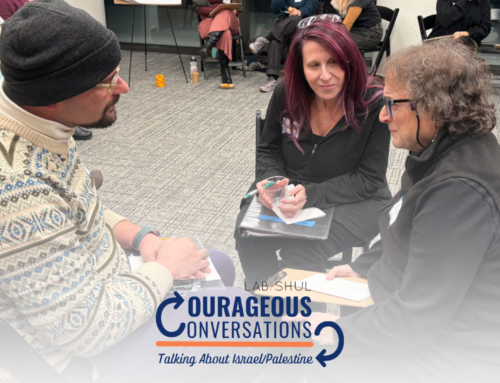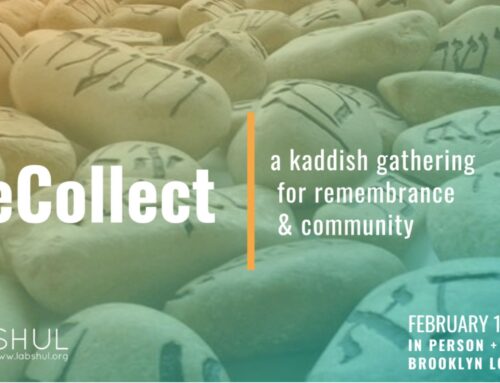
Reading the Megillah in Tel Aviv, 1985; The Dan Hadani Collection, the Pritzker Family National Photography Collection at the National Library of Israel. https://blog.nli.org.il/en/lbh_grogger/
Purim is back, with masked parties, parodies, and pastries named for a long gone hater of the Jews. We have a weird and wonderful sense of dealing with historical traumas.
In synagogues and homes worldwide many will gather for the festive retelling of the Esther Scroll in jubilant celebration of Jewish survival.
It’s been my favorite and most anticipated holiday since I can remember, so it’s with a heavy heart that I’m suggesting we amend one of its most beloved practices this year, for the sake of peace. Call it a ceasefire.
And no I don’t mean the pastries. I mean the groggers. Put them down. I wrote about this idea last year, as we were just coming out of COVID. It feels even more relevant now.
Here’s why.
This Purim, as antisemitism surges, as violence in Israel and Palestine is again on the rise, while an unprecedented wave of protests to defend Israeli democracy keeps growing, Jews everywhere are offered an important, rare, opportunity – a symbolic gesture toward repairing rifts, healing historical hurts, and pausing the seemingly endless cycle of shame, blame, and violence.
Purim has a purpose. It’s here to remind us of our history, with all its twists and turns; Unmasked, this holiday gives us a precious chance to laugh at life, and at ourselves, to air out skeletons, to imagine the world upside down for just a day, so we can hit reset inside each one of us and as a collective entity. It’s a tall order which is why the holiday is mostly relegated to the kindergarten version.
But Purim’s hidden purpose is to help us somehow try and transcend the familiar norms of right and wrong, to question what or who is good or bad for us, divides or unites us, so we can reset our course, with clarity, care, and courage, for the greater good.
We briefly blur our binaries on Purim in order to transform old wounds that helped us survive into the wisdom that will help us thrive.
But the problem is that part of the Purim practice is to keep triggering old wounds that reinforce intergenerational traumas, turning ancient fears, with best intentions, into contemporary fury.
I’m talking about each and every time we make a lot of noise when the name of Haman is mentioned in the Esther Scroll.
I’m talking about ritualized terror that backfires as hate.
Purim developed as a fantasy of power and authority, created by and for defenseless minorities struggling to survive in hostile diasporas. Whether the Esther story is history or myth, it is the only biblical book taking place entirely inside a Persian world, where Jews can only dream of power.
But that is no longer the case.
My Purim Wake up happened in 1994, when I was in my mid 20’s, living in Jerusalem. That morning we woke up to the terrible news of the massacre in Hebron. Baruch Goldstein, an Israeli Jewish settler, Brooklyn born, killed 29 Muslim Palestinians and wounded more than 100, while they were praying at the Cave of the Ancestors in Hebron. In his suicide note he justified his vile act as an echo of Esther’s Scroll, chanted that morning in his synagogue, in which the Persian Jews, relieved to be rescued from annihilation, killed 75,000 Persians in a riot of rage and revenge, sometimes portrayed as self-defense. He justified the killing of Amalek – Haman’s ancestor, the people whose very memory the Torah instructs us to annihilate. Purim has never been the same for me, and for many others, ever since.
Goldestein was condemned by most Jewish leaders but his grave in Hebron is a popular pilgrimage site for many Jews who worship his racist zealotry. Until recently, Israel’s current Minister of National Defense proudly displayed a photo of this terrorist on his office wall.
When 400 Jewish settlers rioted in the Palestinian village of Hawara last week in revenge for the malicious murder of two Jewish brothers by a Palestinian gunman from that village, killing a man, wounding many, burning homes and cars, while pausing to pray the evening prayer – they had Goldstein as a role model for religiously inspired revenge.
And just this past weekend the same groups of Jewish settlers, no longer fundamentalist fringe, now backed by government officials, specifically cited Haman and Amalek as they called on people to continue the attack on Hawara.
This is not the Judaism I grew up on and believe in. This is not done in my name. This perversion of our path needs to be named and negated, before it’s too late.
The commandment to never forget our persecution, and always annihilate the eternal enemy of Israel is already in the Torah, resurfacing each Purim, with extra fury, and under the radar as frivolous fun. But it was never meant to be taken as action.
Where did this custom come from? Originally from Exodus 17:4, where we are told that God will “utterly blot out the remembrance of Amalek from under the Heavens.”
Haman’s ancestors were from Amalek. And Amalek is the grandson of Esau. It’s a family feud gone way wrong for far too long.
As for the noise making toys known in Yiddish as ‘grogger’ they are a medieval European addition to the holiday. Previous generations wrote Haman’s name on a shoe and stamped their feet. Some wrote the evil name on stones and rubbed them together. This tradition is about release of tensions, to be sure, participatory pedagogy for all ages, cultivated over generations of diaspora oppression when all we had was just this day of power fantasy, revenge against the haters hidden behind masks. When else are we allowed to poke fun at our haters?
But is it still a fantasy of power, and is it still a harmless game?
By the time I grew up in Israel in the 1970’s, wooden toys were increasingly replaced by plastic guns.
It’s real guns now.
The distance from a grogger to a gun is small.
These little noise making toys are boomerangs – coming back to get us, and haunt us, with extra force.
Do we want to keep recycling the fear and rage or do we want to find a way to honor our past, take a hold of our present, and be responsible for safer futures?
Is this the year to put the groggers down? Maybe just to try it out.
Instead of hollering each time Haman is mentioned, take responsibility for timeout, pause for deep exhale?
What if we sit in silence for a second, hold our heart or someone’s hand, instead of booing each time the name of fear comes up? What if we talk together about why we are choosing to do so and what we may achieve. Then party.
What if we stop the seemingly never ending cycle of violence if only in this ritual way?
This Purim, let’s name our fears, dance with the skeletons in our closet, celebrate survival and the gift of life, and dispel some of our violent dreams designed by generations of defenseless ancestors. Let’s unmask some long held traumas and traditions that may no longer serve our highest aspirations to be people guided by love, committed to justice, fighting for security, equity and dignity for us – and for all.
Let’s put down the groggers this Purim. For the sake of peace, hope, justice, love, and life.
Rabbi Amichai Lau-Lavie
NYC 2023
More spiritual prep for Purim?
Watch this 2021 conversation between Rabbi Amichai Lau-Lavie and Rabbi Josh Feigelson of the Institute for Jewish Spirituality
https://www.jewishspirituality.org/a-conversation-about-purim-with-rabbi-amichai-lau-lavie/










